-
TrackoBit
Manage commercial vehicles with the new-age Fleet Management Software
TrackoBit -
TrackoField
Streamline your scattered workforce with Field Force Management Software
TrackoField -
Features Resources
-
Blog
Carefully curated articles to update you on industrial trends. -
White Paper
Insightful papers and analysis on essential subject matters. -
Glossary
Explore an alphabetical list of relevant industry terms. -
What’s New
Get TrackoBit & TrackoField monthly updates here. -
Case Study
Explore the cases we solved with our diverse solutions. -
Comparisons
Compare platforms, features, and pricing to find your best fit.
-
About Us
Get to know TrackoBit: our team, ethos, values, and vision. -
Careers
Join the most dynamic cult of coders, creatives and changemakers. -
Tech Support
Learn about our technical support team and services in detail. -
Events
Check out the exhibitions where we left our marks and conquered. -
Contact Us
Connect with us and let us know how we can be of service.
What is Facility Maintenance? Why is it Important?
- Author:Tithi Agarwal
- Read Time:8 min
- Published:
- Last Update: September 19, 2025
Table of Contents
Toggle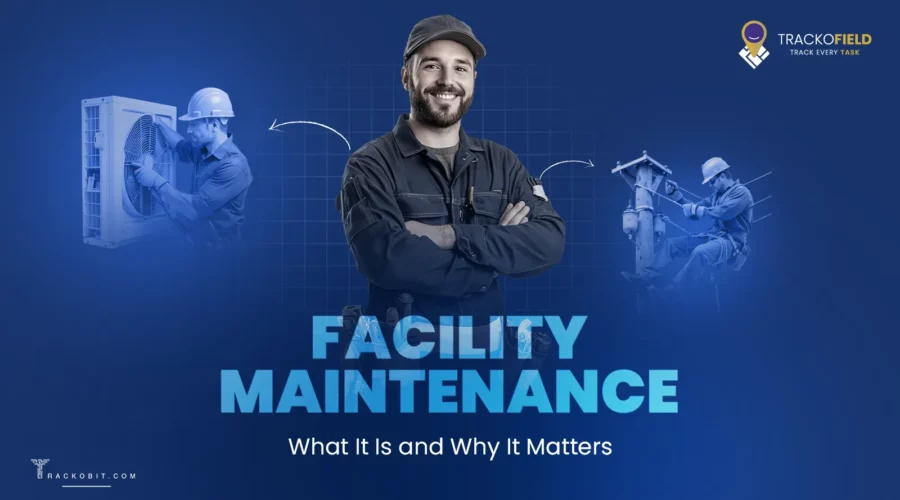
Read about the facility maintenance, its types, and its role in ensuring efficient spaces operations while promoting occupants’ well-being.
Table of Contents
Toggle
Facility maintenance combines all duties and tasks necessary to ensure that buildings, systems, and equipment operate properly, safely, and efficiently. It’s a crucial aspect of managing a facility, whether it’s an office building, a retail store, a residential property, or a public building.
The process mainly handles landscaping, machinery repairs, plumbing, HVAC inspections, and scheduling major repairs.
This article’ll explore what all facility maintenance entails, why it’s essential, and how software like TrackoField can assist with maintenance management.
What is Facility Maintenance?
Facility maintenance is the ongoing management, repair, and upkeep of a facility and its physical assets. It ensures that commercial buildings, hospitals, universities, and manufacturing plants operate effectively, efficiently, and safely.
The facility maintenance process requires the scheduling of skilled technicians who perform a wide range of tasks, including landscaping, emergency repair, pest control, roofing, and parking lot maintenance.
They also maintain many different parts of a facility and its building systems, including electrical systems, heating, ventilation, air conditioning (HVAC) systems, plumbing, security, and groundskeeping.
Facility Maintenance VS. Facilities Management – How Are They Different?
Facility maintenance is about the upkeep and repair of physical assets, while facilities management involves a more strategic role, overseeing both the facility’s operations and its alignment with business goals.
1. Focus
Facility Maintenance: Day-to-day upkeep of the building or facility.
Facility Management: Comprehensive oversight and management of all aspects of the facility including the service technicians.
2. Primary Role
Facility Maintenance: Ensuring that equipment, systems, and infrastructure are functioning properly and safely.
Facility Management: Managing both the physical environment and the people who interact with it, with a focus on efficiency, safety, and productivity.
3. Tasks
Facility Maintenance
- Routine maintenance (e.g., cleaning, HVAC servicing, electrical inspections).
- Preventive and corrective repairs.
- Monitoring and fixing issues with lighting, plumbing, and other building systems.
- Ensuring compliance with safety regulations.
Facility Management
- Overseeing property maintenance, space management, energy management, and security needs.
- Budgeting, procurement, and contract management.
- Strategic planning related to building improvements, upgrades, and space usage optimization.
- Coordinating between various departments, ensuring that the facility supports the business goals.
4. Scope
Facility Maintenance: With a narrow scope, it’s typically focused on the technical aspects of keeping the facility in working order.
Facility Management: With a broader scope, it encompasses not just maintenance but also planning, financial management, and enhancing the overall functionality of the facility.
What is the Importance of a Facility Maintenance?
Without an iota of doubt, facilities maintenance management is an indispensable process in the entire facilities management. The importance of facility maintenance is listed below.
1. Ensures operational efficiency
All building systems, including HVAC units and vital equipment, must function properly to maintain a structure effectively.
Businesses may minimize delays and ensure uninterrupted operations by proactively addressing possible concerns through routine maintenance and inspections.
2. Enhances safety
Frequent maintenance, inspections, and repairs guarantee adherence to building rules, local fire department requirements, and safety standards. Facility maintenance management guards against potential risks for workers and residents by keeping buildings and equipment up to code.
Following the law is essential to reducing legal risks and avoiding the costs and penalties of breaking the law.
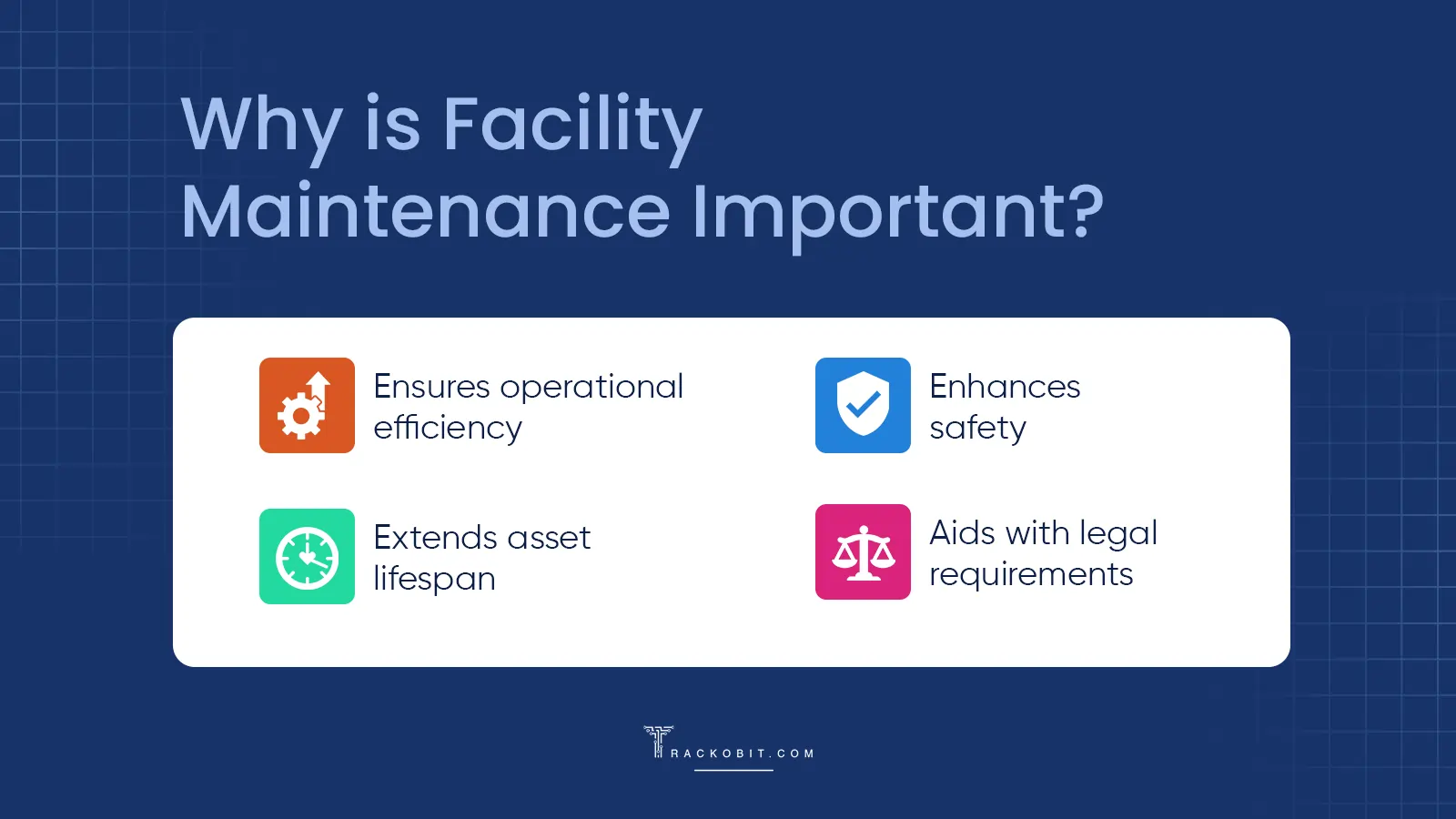
Facility maintenance is important
3. Extends asset lifespan
Preventative and predictive maintenance techniques increase asset longevity. Early detection and resolution of problems help organizations minimize the need for expensive replacements and repairs. This leads to maximizing HVAC performance and longevity and enhancing their asset portfolio.
4. Facilitates compliance with legal and regulatory requirements
The management of facility maintenance is essential to reducing operational hazards. By taking precautions against potential risks and abiding by the rules set forth by the Environmental Protection Agency (EPA) and the Americans with Disabilities Act (ADA), among other regulatory bodies.
What are the Types of Facility Maintenance Strategies?
A comprehensive maintenance scheme typically encompasses several types of facility maintenance:
1. Preventive maintenance
This kind of maintenance entails planned, regular maintenance chores carried out at regular intervals to avoid possible problems. Tasks related to preventive maintenance include cleaning, lubrication, part replacement, and adjustments.
2. Corrective maintenance
Also known as reactive maintenance, corrective maintenance involves repairing or replacing faulty equipment or systems. It is initiated in response to a failure or breakdown.
3. Predictive maintenance
This kind of maintenance forecasts when systems or equipment are likely to break using data and sophisticated analytics. Predictive maintenance can optimize maintenance schedules and resources while assisting in the prevention of unplanned equipment failures.
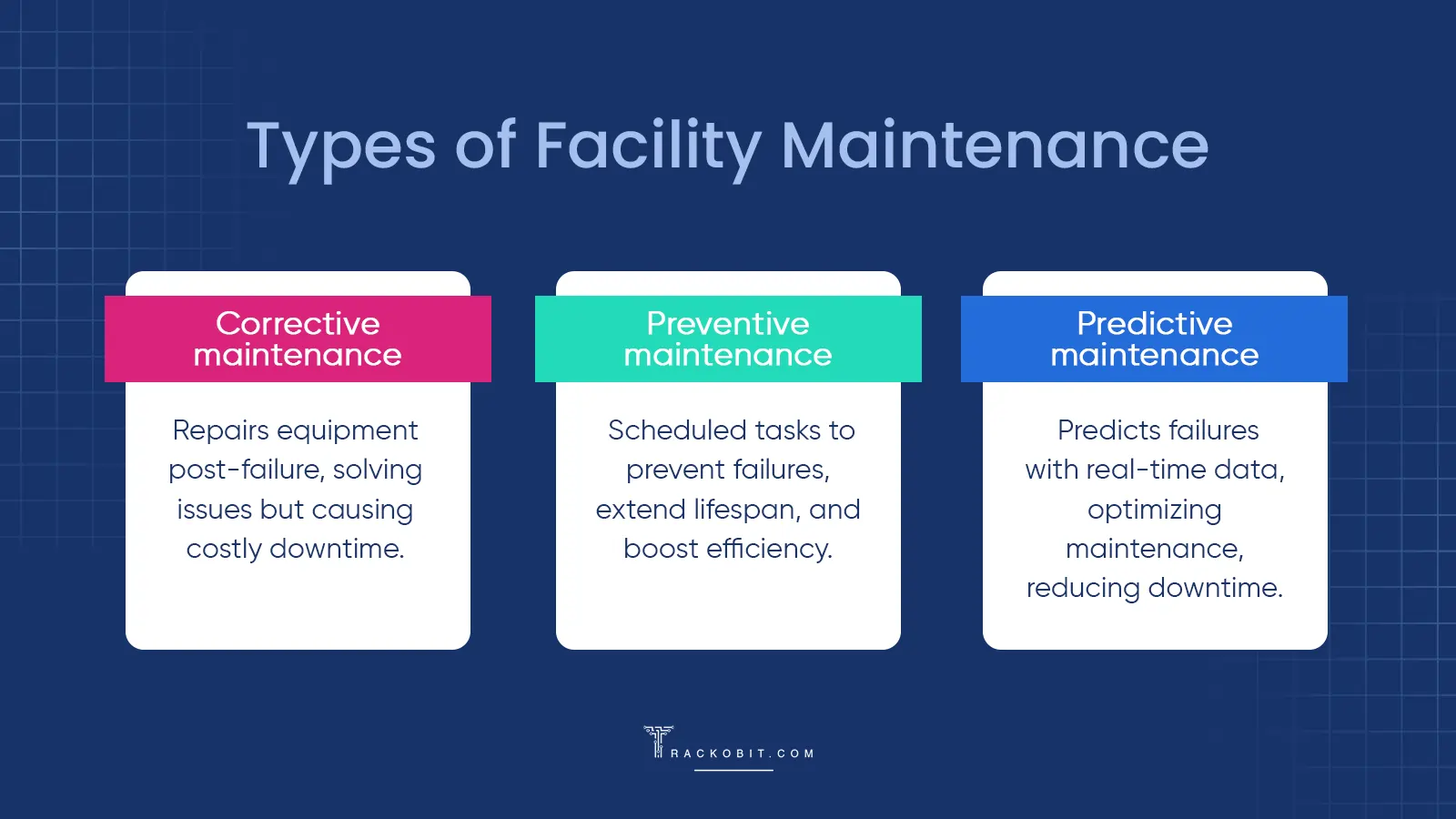
Type of Facility Maintenance
4. Regulatory compliance
Facilities must adhere to relevant safety legislation, codes, standards, and procedures, including fire safety certifications. Regular testing, reporting, documentation, and inspections are a few examples of compliance maintenance.
5. Training and development
Workers who maintain facilities frequently need training and upskilling to stay current on the industry’s best practices, technology, certifications, and laws. For instance, the International Facility Management Association (IFMA) offers certificates that allow maintenance personnel to advance their skills.
What Does a Facility Maintenance Plan Look Like?
Facility maintenance plans generally involve several key steps to ensure that facilities are successfully maintained and operating efficiently:
1. Assess current conditions
Conduct a thorough examination of the facilities to ascertain their present state. Systems, equipment, and infrastructure inspections and audits may be part of this process.
2. Define maintenance goals
Set quantifiable, explicit maintenance goals that complement the organization’s overarching goals. As an example, consider how to increase equipment dependability, decrease downtime, increase asset longevity, improve safety, and maximize energy efficiency.
3. Develop a maintenance strategy
Provide the strategy, tools, and resources needed for efficient upkeep. This approach can involve scheduling, allocating resources, and prioritizing maintenance work. In addition, to predictive, corrective, and preventative maintenance plans.
4. Create a maintenance schedule
Create a maintenance schedule that specifies how often and when maintenance chores should be performed. When creating this timetable, consider operational requirements, resource availability, and the criticality of any systems or equipment.
5. Establish maintenance procedures
Create thorough, understandable maintenance procedures that include detailed instructions on how to complete each activity. Standardize these processes and inform the maintenance staff to ensure consistent execution.
6. Allocate resources
Determine the necessary resources, including personnel, tools, equipment, materials, and a budget, for implementing the maintenance plan.
7. Documentation and reporting
Provide a method for recording all maintenance operations, such as work orders, inspections, repairs, and other pertinent data.
8. Monitor and continuously improve
Review and revise the plan regularly in response to user feedback, performance indicators, and evolving needs. To increase the effectiveness and efficiency of the maintenance program, pinpoint areas that need improvement and implement remedial measures.
Types of Buildings That Require Facility Maintenance Services
1. Large Commercial Buildings
For offices to operate efficiently, they need working equipment and seamless operations. Facility maintenance includes any type of equipment that requires regular or periodic maintenance. Maintaining fully operational vital machinery gives employees a more comfortable and productive work environment.
2. Hospitals
Facility maintenance is very helpful for ensuring a hospital building stays compliant with OSHA’s cleanliness and safety rules. A hospital provides daily operations, not to mention its sheer size.
Hospital preventive maintenance measures, including scheduling inspections for imaging equipment, are the focus of facility maintenance.
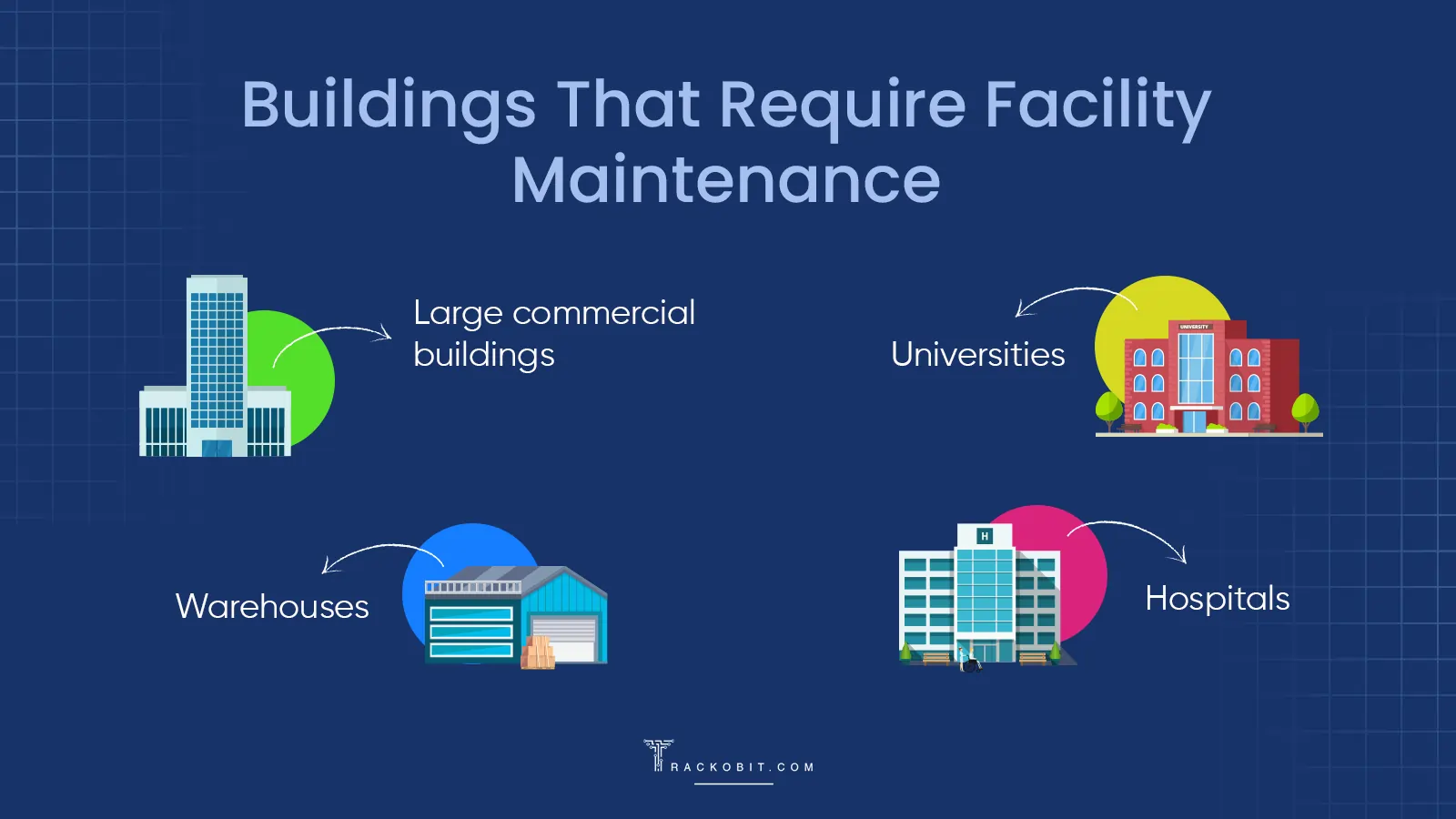
Buildings Requiring Facility Maintenance
3. Universities
Universities are expansive, much like hospitals, because there are so many distinct buildings and facilities on campus. Thus, facility maintenance is essential to maintaining the comfort and safety of faculty, staff, and students.
It includes, regular HVAC and repair inspections, pest management, regular painting of public and common areas, and organizing and replacing furniture and supplies in classrooms.
4. Warehouses
Large pieces of equipment like pallet jacks, conveyors, forklifts, and more are found in warehouses and distribution centers and are all operated internally. Because there is so much equipment, facility maintenance is essential to keeping it all operational and reducing downtime so the warehouse can handle fulfillment more efficiently.
How Does TrackoField Help with Facility Maintenance and Management?
TrackoField’s field force facility management software lets you easily deploy your on-field technical crew across diverse and scattered job sites. Its range of solutions for assigning, tracking, and monitoring tasks helps you close service tickets faster and more efficiently.
The software supports you in:
1. Workflow Automation
There are situations where the facility maintenance service requires multiple employees. For example, Sam is first assigned to inspect the fault for the lift service. Then, Matthew is assigned to carry out the serving part. However, due to the unavailability of equipment and Matthew’s lack of bandwidth, the task gets automatically assigned to Roy.
This way, there is a flow or chain of tasks that involves inspection, servicing, and after-servicing inspection before the ticket is closed. TrackoField’s automated workflow scheduling feature helps assign and align all technicians without flinching.
2. Task Allocation and Tracking
Using Trackofield’s task management makes it easy to allocate facility maintenance tasks to service technicians through automation. It even lets you keep track of the tasks completed by each technician.
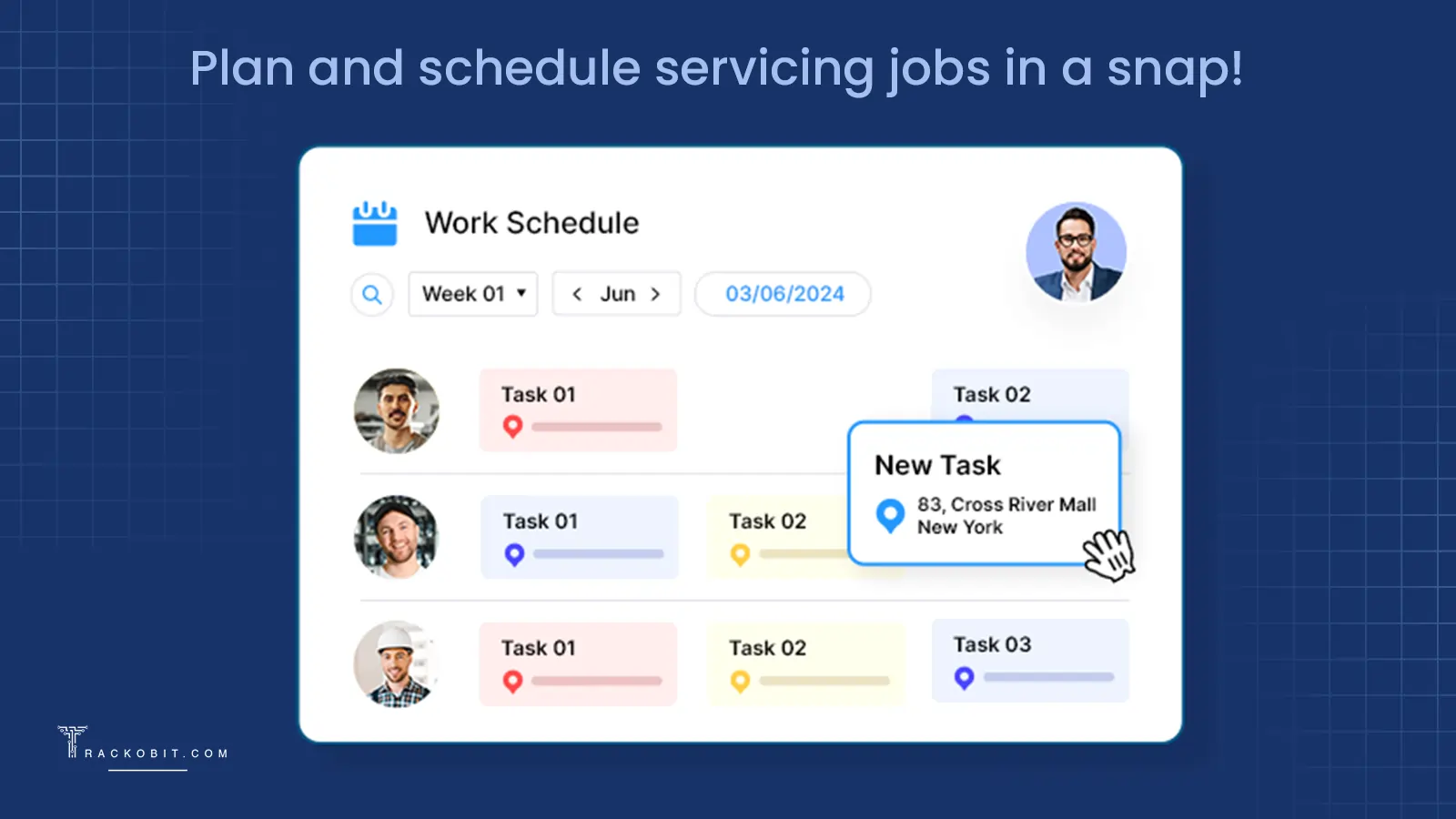
TrackoField’s task scheduling feature
3. Live Technician Crew Tracking
Since the campus is huge and each technician is working on a different job, it can become tough to track them all. But not if you have a real-time tracking feature assisting you. It lets you track employees’ locations live and accurately.
4. Location Verified Attendance Management
A geo-coded attendance feature lets technicians mark their presence directly from the job site, helping verify their field presence. The feature also auto-marks out employees as their shift ends, which helps track your technicians’ and operators’ accurate working hours.
5. Expense Management
The service technicians often have to purchase HVAC tools and travel to job sites. They are going to incur expenses. To speed up the reimbursement process, the technicians can upload bills and receipts directly from the field for claims on their executive app.
6. Barcode Scanning and OTP
Through the executive app, TrackoField’s facility management software allows users to scan barcodes and receive OTP and happiness codes upon completion of service.
7. Custom Forms and Fields
Documentation is a big part of the facility maintenance program. The software comes with custom fields and forms that allow employees to record important information and even attach documents.
8. Geofencing
You can set geofences on multiple sites. They are completely customizable according to the nature of the job. For example, if it’s a one-time service, the geofence will vanish after completion. If it’s a recurring job, the geofence will be permanent.
Apart from that, the geofences can be color and name-coded as well.
Frequently Asked Questions
-
What services are included in facility maintenance?
Facility maintenance services include cleaning, HVAC system upkeep, electrical repairs, plumbing, landscaping, security, pest control, and general building maintenance. It ensures safe, efficient, and well-maintained environments by addressing issues like lighting, heating, ventilation, and equipment functionality, contributing to the overall operational efficiency of facilities.
-
What are the benefits of facility maintenance?
Facility maintenance improves safety, extends equipment life, reduces operational costs, and ensures compliance with regulations. It enhances workplace productivity by minimizing downtime, creates a comfortable environment, and preserves property value. Regular maintenance also helps prevent major repairs, increasing efficiency and reducing long-term expenses.
-
What is the main goal of facility maintenance?
The primary goal of facilities management is to ensure efficient, sustainable operations of physical spaces and assets in order to support an organization's objectives and the well-being of occupants.
-
What is the importance of outsourcing facility maintenance?
Outsourcing facility maintenance provides access to specialized expertise, reduces operational costs, and ensures high-quality service. It allows businesses to focus on core activities while professionals handle building upkeep.
Tithi Agarwal is an established content marketing specialist with years of experience in Telematics and the SaaS domain. With a strong background in literature and industrial expertise in technical wr... Read More
Related Blogs
-

Grameen Credit Score: Everything that NBFCs and MFIs Must Know in 2026
Shemanti Ghosh January 6, 2026Empower the underserved Joint Liability Groups (JLG), Self-Help Groups (SHG), and residents of rural India with better credit assessment and…
-

How MFIs Are Working In Modern Day Scenario? A Complete Breakdown
Mudit Chhikara December 30, 2025How field force automation is helping MFIs transform field operations.
-

Unified Field Workforce Dashboard: Monitor Tasks, Attendance & More In One Place
Mudit Chhikara December 15, 2025Bring full clarity to field operations with a single, real-time field workforce dashboard.
-

Loan Disbursement in NBFCs: From 15 Days to 3 Minutes – Learn How
Shemanti Ghosh December 11, 2025TrackoField’s AI-enabled field force automation software speeds up loan disbursals in NBFC with field agent task monitoring and facial attendance…

Subscribe for weekly strategies to boost field team productivity.
Your inbox awaits a welcome email. Stay tuned for the latest blog updates & expert insights.
"While you're here, dive into some more reads or grab quick bites from our social platforms!"Stay Updated on tech, telematics and mobility. Don't miss out on the latest in the industry.
We use cookies to enhance and personalize your browsing experience. By continuing to use our website, you agree to our Privacy Policy.



































